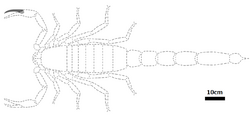Biology:Brontoscorpio
| Brontoscorpio | |
|---|---|

| |
| Size estimation of Brontoscorpio anglicus, with the only evident region (free finger of right pedipalp) highlighted in dark grey | |
| Scientific classification | |
| Domain: | Eukaryota |
| Kingdom: | Animalia |
| Phylum: | Arthropoda |
| Subphylum: | Chelicerata |
| Class: | Arachnida |
| Order: | Scorpiones |
| Family: | incertae sedis |
| Genus: | †Brontoscorpio Kjellesvig-Waering, 1972 |
| Species: | †B. anglicus
|
| Binomial name | |
| †Brontoscorpio anglicus Kjellesvig-Waering, 1972
| |
Brontoscorpio is an extinct genus of scorpion. Remains of the only known species, Brontoscorpio anglicus, were discovered in the St. Maughan's Formation,[1][2] Lochkovian-aged (previously also considered as late Silurian)[3] sandstone from Trimpley, Worcestershire.[3] The species was described on the basis of an incomplete single free finger of a right pedipalp (In31405), almost 10 cm (3.9 in) long.[3][4] The complete animal is estimated to have been 77.2–91.5 cm (2.5–3.0 ft) long for females and 86.2–94 cm (2.8–3.1 ft) long for males,[3] making Brontoscorpio one of the largest known scorpions. The species is characterized by the presence of single condyle and row of thick tubercles on the pedipalp free finger.[3]
Ecology
The remains were found in terrestrial sediments, showing evidence of Brontoscorpio being terrestrial. Brontoscorpio may have gone ashore to escape predation, but due to its size, it would have had difficulty supporting its weight on land and likely lived a primarily aquatic life.[5]
Popular culture
Brontoscorpio was featured in the first episode of the 2005 BBC television series Walking with Monsters. It is shown as aquatic, hunting Cephalaspis, being eaten by Pterygotus.
References
- ↑ "Fossilworks: Brontoscorpio". http://www.fossilworks.org/cgi-bin/bridge.pl?a=taxonInfo&taxon_no=286810.
- ↑ Dunlop, J. A., Penney, D. & Jekel, D. 2020. A summary list of fossil spiders and their relatives. In World Spider Catalog. Natural History Museum Bern, online at http://wsc.nmbe.ch , version 20.5
- ↑ 3.0 3.1 3.2 3.3 3.4 Kjellesvig-Waering, Erik N. (1972). "Brontoscorpio anglicus: a gigantic Lower Paleozoic scorpion from central England". Journal of Paleontology 46 (1): 39–42.
- ↑ Jeram, Andrew J.. "Phylogeny, classification and evolution of Silurian and Devonian scorpions". in Selden, Paul A.. Proceedings of the 17th European Colloquium of Arachnology, Edinburgh 1997, 1998. http://www.european-arachnology.org/proceedings/17th/3Jeram.pdf. Retrieved 2011-04-05.
- ↑ The Biology of scorpions. Polis, Gary A., 1946-. Stanford, Calif.: Stanford University Press. 1990. ISBN 0804712492. OCLC 18991506. https://www.worldcat.org/oclc/18991506.
Wikidata ☰ Q137094 entry
 |

